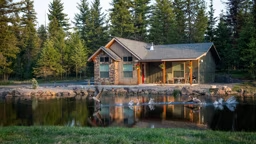Cash: Ready money, dinero, moola.
Pros: Paying cash is by far the least complicated way to pay for a remodeling project. You don’t have to worry about fluctuating interest rates or monthly payments.
Cons: When you use ready money to pay for a remodel, you may incur an opportunity cost by tying up valuable cash-on-hand. Your dollars could potentially be invested elsewhere – earning you more money than you’re saving by financing the project yourself. Also, interest payments on an improvement loan may qualify as a tax-deduction, which – depending on your situation – may
be more practical in the long run.
Home Equity Loan: This takes the equity you’ve built in your primary residence or your cabin and allows you to borrow against it without changing the terms of your original mortgage. Although some lenders will write a loan for 100 percent of your equity, 80 percent is more typical. You’ll get a lump sum and pay it back in equal monthly installments with a fixed interest rate. Home equity loans are also called “second mortgages.”
Pros: The process is easy and lightning fast for those with a solid credit history. A fixed interest rate can protect you from changes in the market and allow you to budget.
Cons: The rates may be higher than a refinanced mortgage, and if you can’t make your payments, your property is on the line. Also, interest may not be tax-deductible (Check with your tax advisor). When you sell your property, the balance of the loan is due immediately.
Home Equity Line of Credit: Lenders will open a line of credit, much like a credit card, using your home or cabin as collateral. The credit limit is based on the appraisal of your property, the balance of your mortgage and your credit history.
Pros: A home equity line of credit allows you immediate access to the money you need for your project. And like a credit card, you incur no expense for funds that are available to you that you don’t spend.
Cons: Because your cabin or first home is collateral, it’s at risk should you get behind in payments. The interest rates are variable, not fixed, and are based upon the changing index that your lender uses – making it difficult to set a budget. Ask your lender how the index for your type of loan has changed recently and where the index is reported. These loans also often feature a large balloon payment at the end of the loan and could lead to another loan – at a less attractive interst rate – to pay off the debt.
Cash-Out Refinancing: Another vehicle to get to your equity is to refinance your cabin or primary residence – whichever has more equity. The amount of your new mortgage above what you owe on your place is the “cash-out” to fund your improvement project.
Pros: This may be a good financial move if you can lower your home loan interest rate – saving you money in the long run.
Cons: Refinancing can be expensive, take a considerable amount of time and should be well researched to avoid costly financial mistakes.
Lucie Amundsen looks forward to cabin living in Maine’s Belgrade Lake region this summer.
Sources included: Jill Burke of Lakeland Mortgage Corporation.
 dreamstime.com
dreamstime.com 









